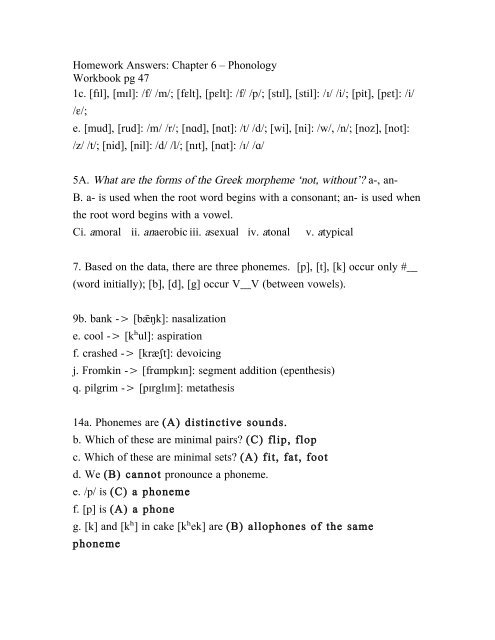Answers to Homework for Ch. 6 - Anthropology
Answers to Homework for Ch. 6 - Anthropology Answers to Homework for Ch. 6 - Anthropology
Homework Answers: Chapter 6 – PhonologyWorkbook pg 471c. [fɪl], [mɪl]: /f/ /m/; [fɛlt], [pɛlt]: /f/ /p/; [stɪl], [stil]: /ɪ/ /i/; [pit], [pɛt]: /i//ɛ/;e. [mud], [rud]: /m/ /r/; [nɑd], [nɑt]: /t/ /d/; [wi], [ni]: /w/, /n/; [noz], [not]:/z/ /t/; [nid], [nil]: /d/ /l/; [nɪt], [nɑt]: /ɪ/ /ɑ/5A. What are the forms of the Greek morpheme ‘not, without’? a-, an-B. a- is used when the root word begins with a consonant; an- is used whenthe root word begins with a vowel.Ci. amoral ii. anaerobic iii. asexual iv. atonal v. atypical7. Based on the data, there are three phonemes. [p], [t], [k] occur only #___(word initially); [b], [d], [g] occur V___V (between vowels).9b. bank -> [bæ̃ŋk]: nasalizatione. cool -> [kʰul]: aspirationf. crashed -> [kræʃt]: devoicingj. Fromkin -> [frɑmpkɪn]: segment addition (epenthesis)q. pilgrim -> [pɪrglɪm]: metathesis14a. Phonemes are (A) distinctive sounds.b. Which of these are minimal pairs? (C) flip, flopc. Which of these are minimal sets? (A) fit, fat, footd. We (B) cannot pronounce a phoneme.e. /p/ is (C) a phonemef. [p] is (A) a phoneg. [k] and [kʰ] in cake [kʰek] are (B) allophones of the samephoneme
- Page 2 and 3: h. In complementary distribution, t
<strong>Homework</strong> <strong>Answers</strong>: <strong>Ch</strong>apter 6 – PhonologyWorkbook pg 471c. [fɪl], [mɪl]: /f/ /m/; [fɛlt], [pɛlt]: /f/ /p/; [stɪl], [stil]: /ɪ/ /i/; [pit], [pɛt]: /i//ɛ/;e. [mud], [rud]: /m/ /r/; [nɑd], [nɑt]: /t/ /d/; [wi], [ni]: /w/, /n/; [noz], [not]:/z/ /t/; [nid], [nil]: /d/ /l/; [nɪt], [nɑt]: /ɪ/ /ɑ/5A. What are the <strong>for</strong>ms of the Greek morpheme ‘not, without’? a-, an-B. a- is used when the root word begins with a consonant; an- is used whenthe root word begins with a vowel.Ci. amoral ii. anaerobic iii. asexual iv. a<strong>to</strong>nal v. atypical7. Based on the data, there are three phonemes. [p], [t], [k] occur only #___(word initially); [b], [d], [g] occur V___V (between vowels).9b. bank -> [bæ̃ŋk]: nasalizatione. cool -> [kʰul]: aspirationf. crashed -> [kræʃt]: devoicingj. Fromkin -> [frɑmpkɪn]: segment addition (epenthesis)q. pilgrim -> [pɪrglɪm]: metathesis14a. Phonemes are (A) distinctive sounds.b. Which of these are minimal pairs? (C) flip, flopc. Which of these are minimal sets? (A) fit, fat, footd. We (B) cannot pronounce a phoneme.e. /p/ is (C) a phonemef. [p] is (A) a phoneg. [k] and [kʰ] in cake [kʰek] are (B) allophones of the samephoneme
h. In complementary distribution, two sounds (B) never appear in thesame environmenti. Allophones (A) must be phonetically similar.j. A sound that is [+s<strong>to</strong>p] [+labial] [+nasal] is (D) [m]k. A redundant feature is (B) predictablel. S<strong>to</strong>p aspiration in English is (B) predictablem. The English vowel nasalization rule is (C) an assimilation rule.n. Rules that involve both phonology and morphology are called (D)morphophonemic ruleso. The term ‘phonotactic constraints’ refer <strong>to</strong> (C) sequential constraintsTextbook pg 2964. [s] and [s̆] are in complementary distribution; [s̆] occurs only be<strong>for</strong>e [i],[s] everywhere else.7. /t/, /d/, /s/, /z/ [-palatal] -> [c̆], [j̆], [s̆], [z̆] [+palatal] / ___j [+palatal][+glide](this is an example of assimilation)8a. [t], [c̆], and [ts] are in complementary distribution.b. /t/ [+alveolar] [+s<strong>to</strong>p] -> [c̆] [+palatal] [+affricate] / ___[i] [+high][+front];/t/ [+s<strong>to</strong>p] ->[ts] [+affricate] / ___[u] [+high] [+back]d. /tatami/ /tukue/ /tutumu//<strong>to</strong>modati/ /tetudau/ /tizu//uti/ /sĭta/ /kata//tɛgami/ /a<strong>to</strong>/ /ko<strong>to</strong>//<strong>to</strong>temo/ /matu/ /tatemono//o<strong>to</strong>ko/ /degusĭ/ /te/
hiti/ /natu/ /turi/



